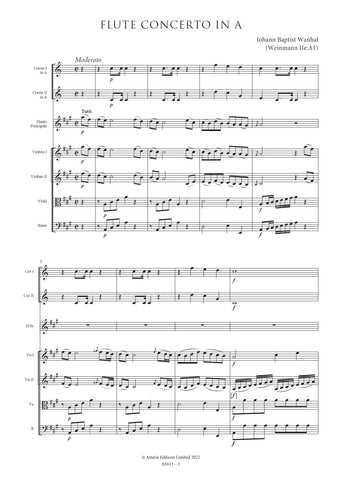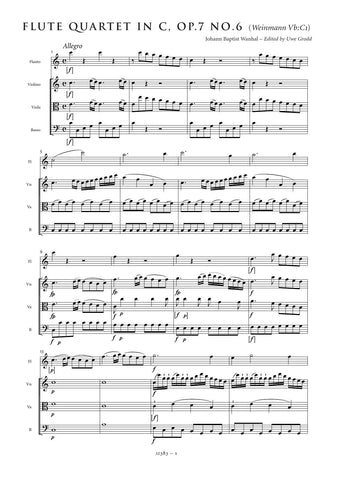Wanhal, Johann Baptist: Flute Concerto in D major (Weinmann IIe:D1) (AE316) – sheet music
Previous Product Next Product
Description |
Wanhal, Johann Baptist (1739-1813)
|
||||||||||||||||||||
Details |
Unlike a number of Wanhal's other flute concertos the present work was not published during his lifetime although MS copies of the work were offered for sale in the Breitkopf Catalogue in the 1776-77 Supplement. It survives, like so many concertos of the period, in a single source; in this case a set of MS parts in theUniversity Library in Lund, Sweden. The wrapper reads:' Concerto / a / Flauto Traversire / Due Violini / Due Oboe / Due Corni / Viola / Basso continuo / et / Basso ripieno / del Sig F.A. Hoffmeister Vanhal / [incipit]-' The differentiation between Basso continuo and Basso ripieno is an interesting one since there is no figuration in the 'Continuo' part which is actually styled 'Basso' on the part itself nor does the Basso ripieno part restrict itself solely to the tutti sections as one might expect. Instead one must draw the conclusion that the Basso continuo part is the cello line and the Basso ripieno part is intended for the double bass. This division of the bass line is very unusual for the concerto of the period although some composers - Wanhal among them made occasional use of independent cello and bass parts in their symphonies. The inclusion of oboes and horns reinforces the symphonic association. Many Viennese concertos of the period either omit the winds entirely or restrict themselves to a pair of horns in the outer movements only.Wanhal not only includes oboes in the orchestra but also employs the full wind section in the slow movement and requires the horn players change crooks part way through the movement. In the absence of both the autograph score and an authentic set of parts, this edition presents as faithfully as possible the intentions of the composer as transmitted in the sole-surviving set of parts. The style and notation of articulation and dynamic markings have been standardised throughout and, where missing from the source, markings have been reconstructed from parallel passages. These are indicated by the use of dotted slurs or brackets. Like most eighteenth-century sources, the present manuscript is inconsistent at in its notation of appoggiature ; these too have been standardised to minimise confusion. Obvious wrong notes have been corrected without comment; text underlay, where confused in the source, has been corrected; editorial emendations with no authority from the source are placed within brackets. Paul Bryan Allan Badley |
||||||||||||||||||||
Score Preview (best viewed in full screen mode) |
|||||||||||||||||||||














